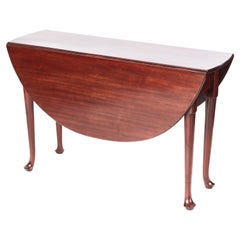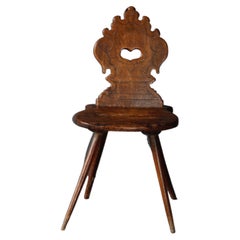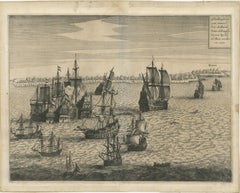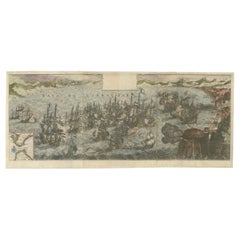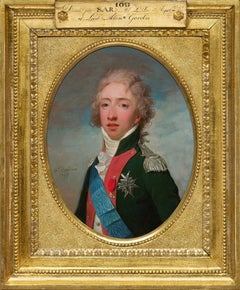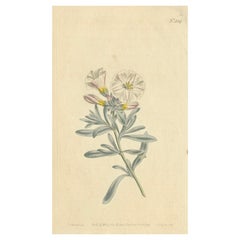Europe
to
188
848
669
344,914
250,332
157,904
141,022
103,903
77,224
50,741
50,130
44,026
35,277
28,316
27,361
22,601
20,016
15,998
15,580
14,776
14,193
11,706
10,739
10,464
7,583
5,839
5,750
4,978
4,406
4,320
3,593
2,818
2,606
2,116
2,114
1,940
1,554
1,471
1,278
1,190
1,136
1,005
954
932
857
716
683
523
500
393
302
281
229
220
196
195
168
165
155
115
109
99
60
45
39
25
15
15
10
7
Period: 1790s
Period: 1650s
Quality Antique George III Mahogany Dining Table
Located in Suffolk, GB
Quality antique George III mahogany dining table having an outstanding solid mahogany top with two drop leaves and supported by four ...
Category
1790s English George III Antique Europe
Materials
Other
Swiss alp folk art escabelle 1793
Located in grand Lancy, CH
Swiss alp folk art escabelle dated 1793 with nice patina
Category
1790s Swiss Antique Europe
Materials
Wood
Capture of Spanish Ships by Dutch Fleet Near Cuba, 1628, Led by Pieter Ita
Located in Langweer, NL
Title: The Capture of Two Spanish Admiral Ships by the Fleet of the Dutch West India Company under Admiral Pieter Adriaensz Ita, 1628
Description: This mid-17th century engraving, c...
Category
1650s Antique Europe
Materials
Paper
Rare Large 1650 Copper Engraving Depicting the Naval Battle of Gibraltar, 1607
Located in Langweer, NL
Title: Rare Large 1650 Copper Engraving Depicting the Naval Battle of Gibraltar, 1607
Description: This rare and exceptionally large copper engraving, measuring 32 x 85 cm, capture...
Category
1650s Antique Europe
Materials
Paper
Two royal portraits (the Duc d'Angoulême and the Duc de Berry) by H.P. Danloux
Located in PARIS, FR
These two royal portraits are a major historical testimony to the stay of the Comte d'Artois (the future Charles X) and his family in Edinburgh in 1796-1797. Given by the sitters to Lord Adam Gordon, the Governor of Edinburgh, and kept by family descent to this day, these two portraits provide us with a vivid and spontaneous image of the Duc d’Angoulême and his brother the Duc de Berry. Danloux, who had emigrated to London a few years before, demonstrate his full assimilation of the art of British portrait painters in the brilliant execution of these portraits.
1. Henri-Pierre Danloux, a portraitist in the revolutionary turmoil
Born in Paris in 1753, Henri-Pierre Danloux was first a pupil of the painter Nicolas-Bernard Lépicié (1735 - 1784) and then, in 1773, of Joseph-Marie Vien (1716 - 1809), whom he followed to Rome when, at the end of 1775, Vien became Director of the Académie de France. In Rome he became friends with the painter Jacques-Louis David (1748 - 1825).
Returning to France around 1782, he settled in Lyon for a few years before returning to Paris in 1785. One of his first portraits was commissioned by the Baroness d'Etigny, the widow of the former Intendant of the Provinces of Gascony, Bearn and Navarre Antoine Mégret d'Etigny (1719 – 1767). He then became close to his two sons, Mégret de Sérilly and Mégret d'Etigny, who in turn became his patrons. In 1787, this close relationship with the d'Etigny family was further strengthened by his marriage to Antoinette de Saint-Redan, a relative of Madame d'Etigny. After his marriage, he left for Rome and did not return to France until 1789. It was during the winter of 1790-1791 that he painted one of his masterpieces, the portrait of Baron de Besenval. Set in a twilight atmosphere, this portrait of an aristocrat who knows that his death is imminent symbolizes the disappearance of an erudite and refined society which would be swept away by the French Revolution.
The Jacobin excesses led Danloux to emigrate to England in 1792; many members of his family-in-law who remained in France were guillotined on 10 May 1794. Danloux enjoyed great success as a portrait painter in England before returning to France in 1801.
During his stay in England, Danloux was deeply under the influence of English portraitists: his colors became warmer (as shown by the portrait of the Duc d'Angoulême that we are presenting), and his execution broader.
2. Description of the two portraits and biographical details of the sitters
The Duc d'Angoulême (1775-1844) was the eldest son of the Comte d'Artois, the younger brother of King Louis XVI (the future King Charles X), and his wife Marie-Thérèse of Savoie. He is shown here, in the freshness of his youth, wearing the uniform of colonel-general of the "Angoulême-Dragons" regiment.
He is wearing the blue cordon of the Order of the Holy Spirit, which was awarded to him in 1787, and two decorations: the Cross of Saint-Louis and the Maltese Cross, as he was also Grand Prior of the Order of Malta.
Born on 16 August 1775 in Versailles, Louis-Antoine d'Artois followed his parents into emigration on 16 July 1789. In 1792, he joined the émigrés’ army led by the Prince de Condé. After his stay in Edinburgh (which will be further discussed), he went to the court of the future King Louis XVIII, who was in exile at the time, and in 1799 married his first cousin Marie-Thérèse Charlotte of France, the daughter of Louis XVI and the sole survivor of the royal family. The couple had no descendants. He became Dauphin of France in 1824, upon the accession to the throne of his father but played only a minor political role, preferring his military position as Grand Admiral. Enlisted in Spain on the side of Ferdinand VII, he returned home crowned with glory after his victory at Trocadero in 1823.
He reigned for a very short time at the abdication of Charles X in 1830, before relinquishing his rights in favor of his nephew Henri d'Artois, the Duc de Bordeaux. He then followed his father into exile and died on 3 June 1844 in Gorizia (now in Italy).
His younger brother, the Duc de Berry, is shown in the uniform of the noble cavalry of the émigrés’ Army. He is wearing the blue cordon of the Order of the Holy Spirit, awarded to him in May 1789, and the Cross of Saint-Louis (partly hidden by his blue cordon).
Born on 24 January 1778 in Versailles, Charles-Ferdinand d'Artois also followed his parents into emigration and joined the émigrés’ army in 1792. After his stay in Edinburgh, he remained in Great Britain, where he had an affair with Amy Brown...
Category
1790s Old Masters Europe
Materials
Canvas, Oil, Wood Panel
Antique Botanical Engraving of Silverbush - Rare 1799 Floral Print by Curtis
Located in Langweer, NL
Antique Botanical Engraving of Convolvulus Cneorum - Rare 1799 Floral Print by William Curtis
This engraving is from the publication "The ...
Category
1790s Antique Europe
Materials
Paper
Pair of Sophisticated Gilt Bronze Candlesticks, Directoire circa 1795
Located in Knivsta, SE
A pair of sophisticated and elegant gilt bronze Candlesticks, Probably made in Paris, France. Directoire circa 1795. Beautifully decorated with leaves.
Wear consistent with age an...
Category
1790s French Directoire Antique Europe
Materials
Gold Plate, Bronze
Elegant pair of Gustavian Carrara marble and Gilt brass Candlesticks from 1790s
Located in Knivsta, SE
Elegant pair of Gustavian Carrara marble and Gilt brass Candlesticks from the 1790s. Simple beauty with some charming patina.
Wear consistent with age and use
Category
1790s Swedish Gustavian Antique Europe
Materials
Carrara Marble, Brass
Charming small Gustavian Shaving Mirror in Mahogany – Sweden, Late 18th Century
Located in Knivsta, SE
Gustavian Shaving Mirror in Mahogany – Sweden, Late 18th Century
Charming small shaving mirror in mahogany (Swietenia mahagoni), made in Sweden during the late 18th century. Execut...
Category
1790s Swedish Gustavian Antique Europe
Materials
Mirror, Mahogany
Late 18th Century Italian Directoire Solid Walnut Armchair
Located in Casale Monferrato, IT
Beautiful late 18th century of the period Directoire Italian antique armchair in solid walnut wood. The armchair is very elegant. The backrest decorated with a carved in wood is beau...
Category
1790s Italian Directoire Antique Europe
Materials
Walnut
Antique Flemish Vitrine in a Bleached Oak
Located in Schellebelle, BE
A beautiful fully original Antique Flemish Vitrine from the Flanders,
Bleached Oak with original Glass,
nice painted interior,
ideal to place in your kitchen or dining room.
Category
1790s Belgian Antique Europe
Materials
Oak
Portrait Enfant Suiveur De Jean Baptiste Greuze (1725/1805 )
By (Circle of) Jean Baptiste Greuze
Located in GOUVIEUX, FR
Huile sur toile Dim avec cadre 50/58 cm Dim sans cadre 37/46 cm Ecole française Suiveur de Jean Baptiste Greuze (1725/1805 ) Elégant portrait d’enfant – Suiveur de Jean-Baptiste Greu...
Category
1790s French School Europe
Materials
Canvas
Still Life of Flowers in Ornamental Urn on Ledge - Dutch Old Master oil painting
By Gerard van Spaendonck
Located in London, GB
This superb vibrant Dutch 18th century Old Master floral oil painting is attributed to circle of Gerard Van Spaendonck. Painted circa 1790, it is a beautiful mixed floral still life flower arrangement in an ornate urn on a marble ledge against a landscape. The flowers include roses, tulips, blue iris and trailing blue morning glory. The carved ornate grey/blue urn on the cream marble ledge create a strong textural contrast with the soft petals and leaves. This is a wonderful example of Dutch 18th century floral oil paintings with fine detail and brushwork.
Provenance. Private Collection, UK (by descent).
Condition. Oil on canvas, 30 inches by 25 inches unframed and in good condition.
Frame. Housed in an ebonised frame, 39 by 34 inches framed and in good condition.
Gerard van Spaendonck (1746-1822) was a Dutch painter. Gerard was born in Tilburg, an older brother of Cornelis van Spaendonck...
Category
1790s Old Masters Europe
Materials
Oil
Louis XV work table panelled in rosewood and bois rose
By Mice di rugiano domenico e c. s.n.c.
Located in Cantù, IT
Louis XV work table panelled in rosewood and bois rose
Private Collection Mice of Domenico di Rugiano
Category
1790s Italian Louis XV Antique Europe
Materials
Wood
Nils Thorsson Scandinavian Marselis Ceramic Bowl for Royal Copenaghen, 1950s
By Royal Copenhagen, Nils Thorsson
Located in Reggio Emilia, IT
Danish ceramic “Marselis” vase bowl serie designed by Nils Thorsson for Royal Copenaghen, 1950s
Please note that the item is original of the period and this shows normal signs of ...
Category
1650s Danish Mid-Century Modern Antique Europe
Materials
Ceramic
George III Diamond and Enamel Navette Pendant, circa 1790
Located in Glasgow, GB
A George III diamond and enamel navette-shaped sentimental pendant, circa 1790, featuring an old cut diamond border on a purple guilloche enameled ground with a central pear-shaped o...
Category
1790s British George III Antique Europe
Materials
Diamond, 9k Gold, Silver, Enamel
Portrait of Major General James Hanson Salmond - British 18thC art oil painting
By Sir Thomas Lawrence
Located in London, GB
This superb British Old Master oil painting is attributed to circle of Sir Thomas Lawrence. Painted circa 1795, the sitter is Major-General James Hanson Salmond (1766–1837) an office...
Category
1790s Old Masters Europe
Materials
Oil
Neoclassical Antique Sterling Silver Goblet - London 1799 - P. A. & W. Bateman
By Peter, Ann & William Bateman
Located in London, London
Hallmarked in London in 1799 by Peter, Anne & William Bateman, this very attractive, George III, Antique Sterling Silver Goblet, features brighcut engraved decoration, a gilt interio...
Category
1790s English Neoclassical Antique Europe
Materials
Sterling Silver
Ni asi la Distingue - Etching by Francisco Goya - 1799
By Francisco Goya
Located in Roma, IT
"Ni asi la Distingue" is an original aquatint realized by Francisco Goya in 1799, from Los Caprichos series, Plate 7, first edition.
Rare and in ...
Category
1790s Old Masters Europe
Materials
Etching, Aquatint
Set of Six French Directoire Chaires, signed J-E Coryn, circa 1800
Located in Greven, DE
Six identical antique chairs
France
Beech
Directoire around 1800
Dimensions: H x W x D: 87 x 45 x 41 cm, seat height: 46 cm
Description:
Beautiful set of provincial French chairs...
Category
1790s French Directoire Antique Europe
Materials
Beech
Rare Gustavian silver cup by Johan Stras from Stockholm, Sweden dated 1792
Located in Knivsta, SE
Rare Gustavian silver cup by Johan Stras from Stockholm, Sweden dated 1792. Johan Stras Johan Stras was an active master silversmith during the years 1777-1796. This cup was made 17...
Category
1790s Swedish Gustavian Antique Europe
Materials
Silver
Amsterdam and the Bridge across the Amstel River, aquatint by S.Ireland, 1795
Located in Langweer, NL
Amsterdam and the Bridge across the Amstel River, aquatint by Samuel Ireland, 1795
This finely executed sepia-tone aquatint titled 'Amsterdam and Bridge across the Amstel' was both ...
Category
1790s Antique Europe
Materials
Paper
17th-Century Original Antique Map of Guangxi Province, China – Qvangsii by Blaeu
Located in Langweer, NL
Title: Antique 17th-Century Map of Guangxi Province, China – "Qvangsii" by Blaeu, Richly Illustrated and Colored
Description: This fascinating 17th-century map of Guangxi Province, historically referred to as "Qvangsii," was crafted by Johannes Blaeu and published in 1655 as part of the *Novus Atlas Sinensis*. Blaeu’s atlas, created in collaboration with Jesuit missionary Martino Martini, introduced European audiences to the geography of China in an unprecedented way. Guangxi Province, known for its striking karst landscapes and important historical trade routes, is depicted here in remarkable detail.
The map highlights the province’s topography, including mountain ranges, rivers, and towns, all meticulously engraved and labeled in Latin. It also captures key trade connections and cultural significance, as Guangxi historically served as a bridge between China and Southeast Asia. The decorative cartouche at the top left is adorned with figures in traditional Chinese costumes, symbolizing the cultural richness of the region and adding artistic elegance to the map.
This map was engraved using the copperplate technique, known for its ability to produce fine, detailed lines. The hand-coloring further enhances the visual impact, clearly distinguishing territorial divisions and natural features. Blaeu’s reputation for both accuracy and artistry is evident in this piece, making it a collector’s item of historical and aesthetic significance.
Guangxi Province, historically referred to as "Qvangsii," is renowned for its breathtaking natural beauty, unique karst landscapes, and cultural diversity. It is famous for its dramatic limestone formations, verdant hills, and picturesque rivers, making it one of the most visually striking regions in China. Guangxi has historically been a significant trade corridor between China and Southeast Asia, contributing to its cultural and economic importance. It is also home to various ethnic minority groups, including the Zhuang, Miao, and Dong, whose traditions and festivals enrich the region's cultural tapestry.
Important places in Guangxi include Guilin, known for its iconic karst mountains and the Li River, which has inspired poets and artists for centuries. Yangshuo, a town near Guilin, is celebrated for its stunning natural scenery and outdoor activities. Nanning, the provincial capital, is an important economic and cultural hub. The Longji Rice Terraces, also known as the Dragon’s Backbone, are an engineering marvel and a popular tourist destination. Beihai, a coastal city, is known for its silver beaches and maritime trade history.
Keywords for this map include 17th-century China map, Guangxi Province, Qvangsii map, antique Chinese maps...
Category
1650s Antique Europe
Materials
Paper
Rabbits Dove and Guinea Pig in an Interior - Italian Old master art oil painting
Located in London, GB
This superb Italian 17th century Old Master animal oil painting is attributed to Baroque artist Giovanni Agostino Cassana. Painted circa 1650 the composition is of two rabbits, a guinea pig and a dove in an interior. The two rabbits, one brown one grey are in the immediate foreground, head to head eating something and the dove is standing to their right. The brown and white guinea pig is sitting above and behind them. As the background is dark the animals really stand out and there is superb detail in their respective fur and feathers. This is a charming Italian Old Master animal oil painting and an excellent example of Cassana's work.
Provenance. Scottish estate.
Condition. Oil on canvas, 24 inches by 20 inches and in good condition.
Frame. Housed in a ebonised frame, 32 inches by 28 inches, in good condition.
Giovanni Agostino Cassana (c.1658 – 6 May 1720) was an Italian painter of the Baroque period. He was a son of Giovanni Francesco Cassana and an elder brother of Niccolò and Giovanni Battista. He was born at Venice, and was initially instructed by his father. In 1670 he worked at the court of Ferdinando de' Medici in Florence and travelled regularly between the two cities, but spent at least the years 1718–1720 in Genoa, where he later died. He painted portraits with some success, but preferred painting animals in the style of Antonio Maria Vasallo, Benedetto Castiglione, and Joannes Fyt, a style which he learned from Jacques van de Kerckhove...
Category
1650s Old Masters Europe
Materials
Oil
English Rare Creamware Pottery Initialled Fox Head Stirrup Cup
Located in Bishop's Stortford, Hertfordshire
A charming and rare antique English creamware pottery fox head stirrup cup probably dating from around 1800. The lightly potted large cup is ...
Category
1790s English George III Antique Europe
Materials
Pottery
Neoclassical Italian Center Table with Imperial Porphyry Marble Tabletop
Located in Rome, IT
Very fine and important center table with square shaped Egyptian porphyry veneered tabletop.
Base in walnut and ebonized wood of the Directoire period of the late 18th century, made with special care and 'original choice of the Radica and marquetry.
Provenance from an aristocratic family descendant of Parma.
Measurements: cm 120 x 120
This particular Imperial grade of porphyry came from a quarry in the Eastern Desert of Egypt.
The term "porphyry" is from Latin and means "purple". Purple was the color of royalty, and the "Imperial Porphyry...
Category
1790s Italian Directoire Antique Europe
Materials
Porphyry
1792 Hand-Colored Plan of St. Petersburg and Moscow in Russia
Located in Langweer, NL
Title: 1792 Hand-Colored Plan of St. Petersburg and Moscow
Description: This rare 1792 map features detailed plans of two iconic Russian cities, St. Petersburg and Moscow. The upp...
Category
1790s Antique Europe
Materials
Paper
Hogarth's 1756 'France' Satirical Print: A Scathing Critique - Published in 1798
Located in Langweer, NL
Hogarth's 1756 "France" Satirical Print: A Scathing Critique
Step into the world of 18th-century satire with this rare 1756 William Hogarth print, "France," from his "France and E...
Category
1790s Antique Europe
Materials
Paper
Pair of Large Scale Original Antique Architectural Prints, Circa 1790
Located in St Annes, Lancashire
Wonderful pair of architectural prints.
Copper-plate engravings by J.Newton after designs by Vetruvius
Published C.1790
Unframed and not matted.
Category
1790s English Classical Roman Antique Europe
Materials
Paper
Pair of Gilt and Patinated Bronze Candlesticks. Directoire, Late 18th Century
Located in Knivsta, SE
A Pair of Gilt and Dark-Patinated Bronze Candlesticks – French Directoire, Late 18th Century
An exquisite pair of French gilt and dark-patinated bronze candlesticks, crafted during ...
Category
1790s French Directoire Antique Europe
Materials
Bronze
George III 22ct Gold and Enamel Mourning Ring, 1795
Located in Glasgow, GB
A George III 22ct yellow gold black and white enamel memorial mourning ring. The ring bears the inscription 'JONATṈ GODWIN·OB:21·JULY·1795·AE:80.' to the exterior of the band.
The r...
Category
1790s British George III Antique Europe
Materials
Gold, 22k Gold, Yellow Gold, Enamel
Knight of the Order of Saint Hubert: 1791 Colored Engraving in Formal Attire
Located in Langweer, NL
Knight of the Order of Saint Hubert: 1791 Hand-Colored Engraving in Formal Attire
This impressive hand-colored engraving, titled "Ritter des St. Hubertus Ordens" (Knight of the Order of Saint Hubert), portrays a knight of this esteemed order dressed in opulent ceremonial attire. The knight is adorned in a black brocade cloak with intricate floral patterns, layered over a formal suit of red and gold accents. The ensemble is complemented by a flamboyant hat featuring a dramatic red plume, indicative of the high status associated with the Order. The knight also wears the insignia of the Order, including a golden cross...
Category
1790s Antique Europe
Materials
Paper
Map of Europe Highlighting Ancient and Modern Geographical Divisions (1794)
Located in Langweer, NL
Map of Europe Highlighting Ancient and Modern Geographical Divisions (1794). Germany, France, Italy, Spain, and the British Isles – Map by D’Anville (1794).
This detailed 18th-cent...
Category
1790s Antique Europe
Materials
Paper
Canton Fur Trader: A Vibrant 1799 Glimpse into China's Commerce
Located in Langweer, NL
Title: "Canton Fur Trader: A Vibrant 1799 Glimpse into China's Commerce"
Description: This detailed print, labeled as Plate 43 from the series "Costumes of China," depicts a fur tra...
Category
1790s Antique Europe
Materials
Paper
Original Antique Map of Spain and Portugal, circa 1790
Located in St Annes, Lancashire
Super map of Spain and Portugal
Copper plate engraving by A. Bell
Published, circa 1790.
Unframed.
Category
1790s English Other Antique Europe
Materials
Paper
Portrait of a man during French Revolution
Located in BELEYMAS, FR
Antoine VESTIER, attributed to
(Avallon, 1740 - Paris, 1824)
Portrait of a man under the Revolution
Oil on canvas
H. 46 cm; L. 37 cm
Circa 1793-95
This beautiful unsigned portrait i...
Category
1790s French School Europe
Materials
Canvas, Oil
Italian Wooden Desk Chest of Drawers
By Italian Sculptor 19 th Century
Located in Milano, IT
In the vast world of antique furnishings, few pieces have the ability to convey intrinsic beauty and artisanal mastery as profoundly as the exquisite Italian walnut chest of drawers ...
Category
1790s Italian Mid-Century Modern Antique Europe
Materials
Marble
Knight of the Teutonic Order: 1791 Hand-Colored Engraving in Reception Attire
Located in Langweer, NL
Knight of the Teutonic Order: 1791 Hand-Colored Engraving in Reception Attire
This magnificent hand-colored engraving, titled "Ritter des deutschen Ordens am Tage der Aufnahme" (K...
Category
1790s Antique Europe
Materials
Paper
Cochineal Cactus and Kermes Oak: Hand-Colored Engraving from 1798
Located in Langweer, NL
Title: Cochineal Cactus and Kermes Oak: Hand-Colored Engraving from Bertuch's "Bilderbuch für Kinder" (1795)
Description: This vibrant hand-colored copperplate engraving from Frie...
Category
1790s Antique Europe
Materials
Paper
Natural History Engravings Compilation: Illustrations of Fish Species, 1790
Located in Langweer, NL
This exquisite compilation showcases two engravings (not framed!) of various fish species from *Histoire Naturelle*, a significant 18th-century work on natural history. The engraving...
Category
1790s Antique Europe
Materials
Paper
Venetian Elegance: Knight of St. Mark in 18th-Century Hand-Colored Engraving
Located in Langweer, NL
Title: Knight of the Order of St. Mark in Venice, 18th-Century Hand-Colored Engraving
Description:
This exquisite hand-colored engraving depicts a Knight of the Order of St. Mark ...
Category
1790s Antique Europe
Materials
Paper
17th Century Italian Commode with Secretaire
Located in Vo', Veneto
"Canterano" chest of drawers with flap/desk
Measurements: H. 102 cm - W. 142 cm - D. 62 cm
Period: 1600
Origin: Emilia - Italy
Wood: Walnut, Poplar
Description:
Beautiful "Canteran...
Category
1650s European Baroque Antique Europe
Materials
Nutwood
Epirus Albania - Etching by Johannes Janssonius - 1650s
By Johannes Janssonius
Located in Roma, IT
Epirus Albania is an ancient map realized in 1650 by Johannes Janssonius (1588-1664).
Good conditions.
From Atlantis majoris quinta pars, Orbem maritimum [Novus Atlas, volume V: ca...
Category
1650s Modern Europe
Materials
Etching
Nils Thorsson Scandinavian Marselis Ceramic Vase for Royal Copenaghen, 1950s
By Nils Thorsson, Royal Copenhagen
Located in Reggio Emilia, IT
Ceramic scandinavian vase serie “Marselis” designed by Danish artist Nils Thorsson for Royal Copenaghen, Denmark 1950s
Please note that the item is original of the period and this...
Category
1650s Danish Mid-Century Modern Antique Europe
Materials
Ceramic
Georgian Rare Rose Cut Diamond 18 KT Brooch Pendant
Located in Napoli, IT
This Georgain era brooch pendant is 1790 ca
18 Kt solid gold topped by silver
Typical flower and leaf design so loved by the Georgians artful modelled in a tri-dimensional manner r...
Category
1790s European Georgian Antique Europe
Materials
Diamond, 18k Gold
Antique Georgian Period Chest of Drawers
Located in London, GB
A wonderful antique Georgian period chest of drawers. This was made in England, it dates from around the 1790-1810 period.
It is of outstanding quality, it is very well built and it...
Category
1790s British George III Antique Europe
Materials
Wood
Caughley Dish, Harlequin Pattern in Style of Donegall Service, ca 1793
By Chamberlains Worcester, Caughley Porcelain
Located in London, GB
This is a beautiful and intriguing porcelain dish made by Caughley and decorated at Chamberlains Worcester in or shortly after 1793. The dish has a "harlequin" pattern with six diffe...
Category
1790s English Neoclassical Antique Europe
Materials
Porcelain
Original 17th-Century Antique Map of Nanjing Province, China – by Blaeu
Located in Langweer, NL
Title: 17th-Century Antique Map of Nanjing Province, China – "Nanking sive Kiangnan" by Blaeu, with Decorative Details
Description: This captivating 17th-century map of Nanjing Pr...
Category
1650s Antique Europe
Materials
Paper
Raymond du Puy: 1791 Engraving of the First Grand Master of Hospitallers
Located in Langweer, NL
Raymond du Puy: 1791 Hand-Colored Engraving of the First Grand Master of the Hospitallers
This captivating hand-colored engraving, titled "Raymund du Puy, erster Großmeister des J...
Category
1790s Antique Europe
Materials
Paper
Derby Porcelain Georgian Rare Hand Painted Dish
By Derby
Located in Bishop's Stortford, Hertfordshire
A rare and unusual Georgian Derby Porcelain dish finely hand painted colored enamels dating from around 1790. The oval shaped dish has a raised scalloped rim and is hand painted with...
Category
1790s English George III Antique Europe
Materials
Porcelain
Large Simple Neoclassical Danish Mahogany Armoire, ca 1790
Located in Jesteburg, DE
A very impressive and simple late 18th century linen cupboard or armoire of pleasing proportions and a good, authentic finish to the Mahogany, not too shiny or to distressed, retaining its original giltbronze mounts. This would work equally well as a bar cabinet of TV trunk...
Category
1790s Danish Neoclassical Antique Europe
Materials
Mahogany
1810 Hand-Coloured Engraving - Tatar Peasants of the Crimean Peninsula
Located in Langweer, NL
1810 Hand-Coloured Engraving - Tatar Peasants of the Crimean Peninsula
Description: This 1810 hand-coloured copperplate engraving from Carl Bertuch's "Bilderbuch für Kinder" ("Picture Book for Children") presents a lively scene of Tatar peasants in the Crimean Peninsula (modern-day Ukraine). The engraving captures rural daily life in vivid detail, depicting various activities that reflect the agricultural lifestyle of the region.
In the foreground, a peasant, smoking a pipe, points while instructing a child, creating an engaging snapshot of a family scene. Nearby, a woman, dressed in traditional clothing, is shown milking a dairy cow, demonstrating the importance of livestock to the community's economy. To the left, a farmer leads two Bactrian camels pulling a hay wagon, showcasing the use of these hardy animals for heavy labor and transportation in the region.
The background features thatched-roof homes, with a minaret rising above them, symbolizing the cultural influence of Islam in the region. The peaceful pastoral setting, with cows grazing and a well in the foreground, further emphasizes the agricultural way of life. The detailed hand-colouring adds vibrancy to the scene, highlighting the distinct attire and activities of the Crimean Tatar...
Category
1790s Antique Europe
Materials
Paper
Regal Splendor of the Grand Master of the Constantinian Order - Engraving 1791
Located in Langweer, NL
Grand Master of the Constantinian Order - 18th-Century Engraving
This captivating hand-colored engraving, titled "Großmeister des Constantiner-Ord...
Category
1790s Antique Europe
Materials
Paper
1654 Nicolas Sanson Map of Southern India and Southeast Asia
Located in Langweer, NL
1654 Nicolas Sanson Map of Southern India and Southeast Asia - Partie Meridionale de L'Inde
This 1654 map by Nicolas Sanson, titled "Partie Meridionale de L'Inde en deux Presqu'Is...
Category
1650s Antique Europe
Materials
Paper
Original 17th-Century Antique Map of Fujian (Fokien) Province, China – by Blaeu
Located in Langweer, NL
17th-Century Antique Map of Fujian Province, China – "Fokien" by Blaeu, with Decorative Cartouches
Description: This stunning 17th-century map of Fujian Province, historically ref...
Category
1650s Antique Europe
Materials
Paper
Original Antique 17th-Century Map of Shanxi (Xansi) Province, China – by Blaeu
Located in Langweer, NL
Antique 17th-Century Map of Shanxi Province, China – "Xansi" by Blaeu, with Artistic Cartouches
Description: This beautifully engraved map of Shanxi Province, historically referred to as "Xansi," was created by Johannes Blaeu in 1655 as part of his renowned *Novus Atlas Sinensis*. This atlas was the first comprehensive Western collection focused on Chinese geography, produced with the guidance of Jesuit missionary Martino Martini. Blaeu’s attention to detail and artistic flair are evident in this representation of Shanxi, highlighting mountains, rivers, cities, towns, and key geographic features. The Great Wall of China, an iconic landmark, is also depicted.
The map includes decorative cartouches that enhance its aesthetic appeal. The upper-left corner features the map's title framed in an ornate design, while the lower-right corner showcases a seated figure in traditional Chinese attire alongside a small globe, symbolizing the merging of European cartographic expertise and Chinese knowledge. Each city and geographic feature is labeled in Latin, making it a fascinating historical artifact of cross-cultural exploration.
This map was crafted using the copperplate engraving technique, prized for its ability to produce fine, precise details. It is further embellished with hand-coloring, which brings the landscape and decorative elements to life. Blaeu’s maps are highly regarded for their accuracy, artistry, and historical significance, making this piece a valuable collectible.
Shanxi Province, historically referred to as "Xansi," is renowned for its historical significance, natural landscapes, and rich cultural heritage. The region has been a crucial center of Chinese history and culture for centuries. Its name, meaning "West of the Mountains," refers to its location west of the Taihang Mountains. Shanxi has long been known for its coal resources, which have made it an important economic hub in modern times.
Important places in Shanxi include Pingyao, a UNESCO World Heritage Site known for its well-preserved ancient city walls and traditional Chinese architecture. The Yungang Grottoes, near Datong, are another UNESCO site, famous for their intricate Buddhist carvings and statues. Mount Wutai, one of China’s Four Sacred Buddhist Mountains, is a significant religious site that attracts pilgrims and tourists alike. Taiyuan, the provincial capital, is known for its historical sites, including the Jinci Temple. Shanxi is also known for its role in the early development of Chinese banking, particularly during the Ming and Qing Dynasties.
Keywords include antique map of Shanxi, Xansi map, Pingyao, Yungang Grottoes, Mount Wutai, 17th-century China map...
Category
1650s Antique Europe
Materials
Paper
Stag Beetles and Rhinoceros Beetles, 1798 Hand-Colored Copperplate Engraving
Located in Langweer, NL
Title: Stag Beetles and Rhinoceros Beetles, 1798 Hand-Colored Copperplate Engraving
Description: This hand-colored copperplate engraving from Friedrich Johann Bertuch's "Bilderbuch ...
Category
1790s Antique Europe
Materials
Paper
17th-Century Original Antique Map of Hunan and Hubei Provinces, China – by Blaeu
Located in Langweer, NL
Title: 17th-Century Antique Map of Hunan and Hubei Provinces, China – "Hvqvang" by Blaeu, Richly Detailed and Illustrated
Description: This beautiful 17th-century map of the regions that now comprise Hunan and Hubei Provinces, historically referred to as "Hvqvang," was created by Johannes Blaeu and published in 1655 as part of the *Novus Atlas Sinensis*. This map, drawn with input from Jesuit missionary Martino Martini, provides a meticulous representation of central China’s geography, capturing its rivers, towns, and mountainous terrain.
The Yangtze River (Changjiang) is prominently featured, emphasizing the region’s importance as a vital waterway for trade and transportation. Wuhan, now a modern metropolis, and Changsha, the capital of Hunan Province, were historically significant cities that appear on the map. The area is also notable for its fertile lands and contributions to China’s agricultural prosperity, particularly in rice and tea production.
The decorative cartouche in the lower-right corner features two figures in traditional Chinese attire standing amid bamboo, symbolizing the cultural and natural richness of the region. Blaeu’s map combines precision and artistry, with vibrant hand-coloring distinguishing boundaries and geographical features. The copperplate engraving ensures fine detail, making this map a remarkable historical artifact.
Condition: Near excellent. Clean impression with vivid hand-coloring. Wide margins with minor age-toning appropriate for its age.
Framing Tips: Use a neutral double mat and a gilt or dark wood frame to enhance the presentation. UV-protective glass is recommended to preserve the vivid hand-coloring and intricate engraving details.
Hunan and Hubei, historically referred to as "Hvqvang," are known for their strategic location along the Yangtze River and their cultural and economic significance in Chinese history. The region’s fertile lands have supported extensive rice cultivation, earning it the title of one of China’s "breadbaskets." Hubei, with Wuhan at its center, has long been a hub of transportation and trade, owing to the convergence of the Yangtze and Han Rivers. Hunan, with Changsha as its capital, is known for its rich cultural heritage and contributions to Chinese literature and art.
Important places in the region include Wuhan, an ancient trade center, and Changsha, known for its historical sites and cultural prominence. The Yangtze River, a key feature on the map, highlights the region’s historical importance as a major waterway for commerce and agriculture. Other notable features include Dongting Lake, a vital ecological and cultural landmark, and the surrounding mountainous areas that have shaped the region’s history and development.
Keywords: antique map of Hunan, Hubei map, Hvqvang map, Yangtze River map, 17th-century Chinese map...
Category
1650s Antique Europe
Materials
Paper
Gigi Radice Mid-Century Modern Italian Velvet Curved Sofa for Minotti, 1950s
By Gigi Radice, Minotti
Located in Puglia, Puglia
Sofa designed by Gigi Radice for Minotti. Made with solid wood structure and ivory velvet upholstery and polished brass legs. The sofa is authentic, only the upholstery has been repl...
Category
1650s Italian Mid-Century Modern Antique Europe
Materials
Brass
Villagers in a Landscape - Flemish 17thC art figurative landscape oil painting
Located in London, GB
This fantastic Flemish 17th century Old Master oil painting is by Thomas Van Apshoven. It was painted circa 1650 and depicts a village with figures outside a tavern, eating, drinking and dancing. Beyond are more dwellings, villagers and animals, all under a blue summer's sky. The detail, brushwork and vibrant colouring are superb. This is an excellent example of Apshoven's work and a typical subject he loved to paint.
Provenance. Leominster estate.
Wax stamp verso.
Condition. Oil on panel, 22 inches by 17 inches and in good condition.
Frame. Housed In beautiful gilt frame, 30 inches by 25 inches and in good condition.
Thomas van Apshoven (1622– 1664) was a Flemish painter known for his landscapes with peasant scenes and genre scenes in interiors. His genre scenes depict village festivals, the interiors of taverns, village scenes or landscapes with peasants engaged in various activities, singeries, guardroom scenes and laboratories of alchemists. Some still lifes have also been attributed to him. His themes and style are close to that of David Teniers the Younger. He was born on 30 November 1622 in Antwerp as the eldest son of Ferdinand van Apshoven the Elder and Leonora Wijns. His father was a painter who had studied with Adam van Noort and had become a master of the Antwerp Guild of Saint Luke in 1596. No paintings by his father are known. His younger brother Ferdinand van Apshoven the Younger became also a successful painter. Thomas studied under his father. Some sources state that he became a pupil of the prominent genre painter David Teniers the Younger. It is more likely, however, that he was an imitator of Teniers. He was registered as a 'wijnmeester' [son of a master] in the Guild of St. Luke of Antwerp in the guild year 1645–1646. He married Barbara Janssens on 22 March 1645. The couple had four children. The godfathers of the children included the painters Victor Wolfvoet...
Category
1650s Old Masters Europe
Materials
Oil
